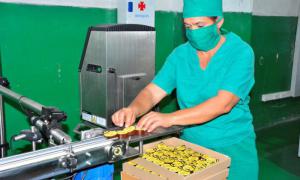
SANCTI SPÍRITUS.— Cuba has for decades sold honey in markets as demanding as the European, but the national product, of recognized quality, reaches the Old Continent in 210-liter tanks (55 gallons), a reality that the Cuban Beekeeping Enterprise is intent upon changing, with the creation of more attractive sales conditions, among them a big change in presentation formats.
Toward this end, recently installed at the Sancti Spíritus plant is a line for individual sized mini-pacs (19 grams), and in the near future another line will be concluded to package honey in 20 different formats, similar to one currently operating today in the El Cano neighborhood, in the Havana municipality of La Lisa, which serves the tourist market and higher end retail stores.
According to engineer Alberto Bravo Pérez, plant director, a basic enterprise unit (UEB) that processes honey from Cienfuegos, Villa Clara, Sancti Spíritus, Ciego de Ávila and recently also from Camagüey, the new line, with Spanish technology and the capacity to fill some 4,680 packets a day, represents a significant step forward in national efforts to add value to export products.
As a result of the increased availability of raw material and the favorable technical state of the industry, last year the Sancti Spíritus plant was able to process 3,290 tons of honey - much more than planned - most of which was destined for export.
The Sancti Spíritus plant also produces wax sheets, placed in hives to support greater efficiency in the production process, of which 2,749 boxes were manufactured in 2019, enough to meet the demand of central provinces and contribute to other regions of the country.
Affiliated with the Cuban Beekeeping Enterprise, part of the Agroforestry Central Enterprise Management Group supervised by the Ministry of Agriculture, the three plants of this type in Artemisa, inaugurated in July last year, Sancti Spíritus and Contramaestre are responsible for the process of filtering, homogenizing, classifying and packaging honey for its subsequent marketing.
Experts believe that the large-scale exploitation of beehive products, including pollen, propolis, royal jelly and venom could make a significant economic contribution, comparable to that of honey itself.















